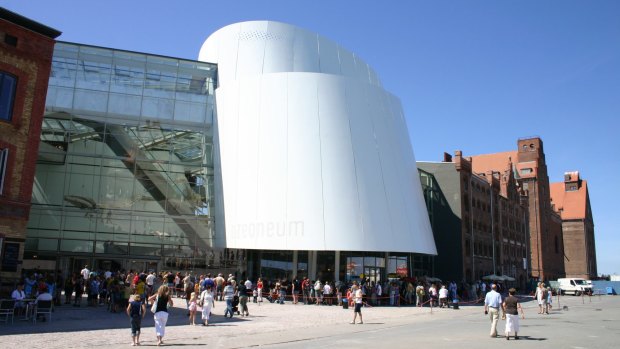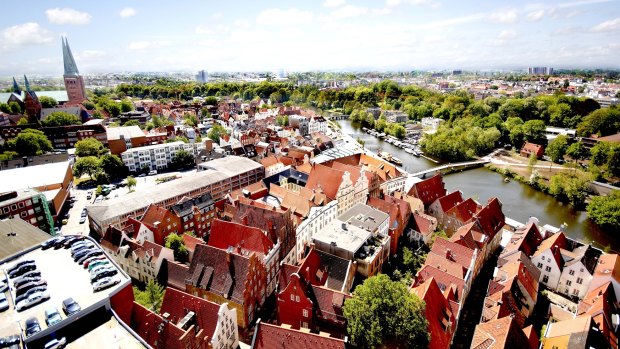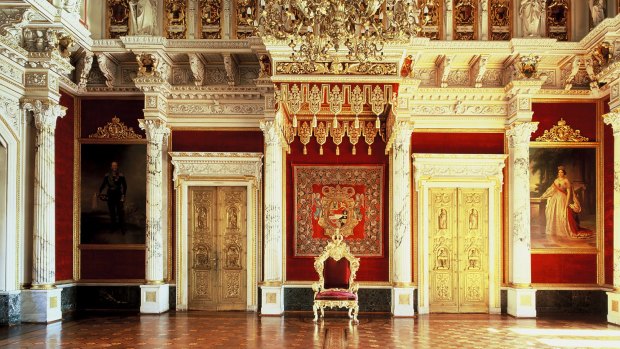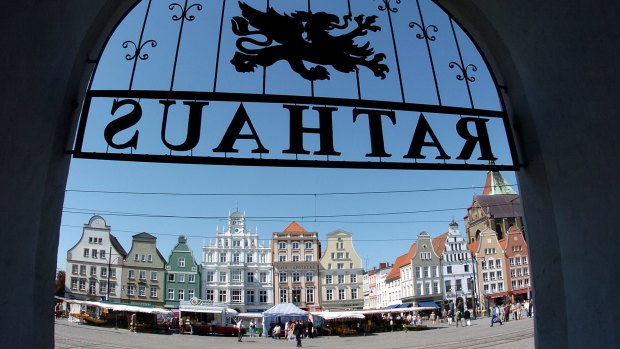This was published 8 years ago
Best day trips from Berlin: Germany's most charming small towns
By Ute Junker

Ozeaneum, Stralsund.Credit: Tourismuszentrale Stralsund
Those Berliners have it all. Not only do they live in one of the world's most exciting cities; they are also surrounded by some of Europe's loveliest day trip destinations; add a day (or two) to your itinerary and discover some of Germany's hidden gems.
SCHWERIN: CITY ON THE SEVEN LAKES
It doesn't get much more romantic than this. A pretty city surrounded by a series of lakes, its baroque streetscapes blanketed by parklands and forest, Schwerin offers one Instagram moment after another. The Grand Dukes of Mecklenburg spent three centuries turning their capital into a showpiece, and it still impresses visitors today: so much so, that the town is hoping to be named as Germany's next World Heritage site.

St. Peter's observation platform 50 metres above ground offers the most marvellous views.Credit: Patrick de Jourdan
The city's centrepiece is its island castle, a polyglot concoction with onion domes and Gothic turrets, art nouveau frills and a dash of neo-classical. Architectural purists hate it; everyone else starts snapping away.
Take some time to explore the city's cobbled squares and narrow alleys. From the main square, head north to the baroque Schelfstadt district, winding your way back via the boutique shops on Munzstrasse and enjoying a reviving beverage at one of Schwerin's grand cafes, such as Café Prag.
ROSTOCK: MARITIME FLAIR

Schwerin Schloss throne room.
There's something you should know about Rostock's town hall. It is painted pink. This may be considered unremarkable in a city such as Buenos Aires, where people tango in the streets, but in the more frigid climate of northern Germany, such a flamboyant approach to municipal architecture is unexpected.
Rostock, however, has a defiantly frivolous streak. Witness the Fountain of Joy, erected in the University Square to celebrate the end of the rebuilding program that resurrected the city after the devastation of World War II. Judging by the naked frolickers that decorate the fountain, the good folk of Rostock were feeling distinctly frisky at the time. Today's inhabitants remain fond of the landmark, which they have affectionately dubbed the Porn Fountain.
Oddly for a port city, Rostock lies 11km inland. A pleasant boat trip down the river takes you to Warnemünde, Rostock's welcoming coastal outpost. With its streets lined with colourful fishermen's cottages and its fleet bobbing on the water, a visit to Warnemünde makes a lovely coda to any Rostock visit.

Oddly for a port city, Rostock lies 11km inland and has a defiantly frivolous streak.Credit: Thomas Haentzschel/ nordlichtor
WISMAR: A HEADY BREW
It may seem hard to believe, but back in the 14th century, the pretty little town of Wismar was a force to be reckoned with. Along with its 8000 inhabitants and 182 breweries, Wismar had a leading role in the Hanseatic League, a medieval trading confederation that was so powerful, it once declared war on Denmark. Today, Wismar is best known for its perfectly preserved medieval streetscape which has won it, in conjunction with nearby Stralsund (see below), a World Heritage listing.
The best way to see Wismar, however, is to let yourself get lost in the narrow streets — curved to stop the wind — and make your own discoveries. From lovely thoroughfares such as Scheunenstrasse, lined with gabled houses, former warehouses and breweries, to old merchant houses with the goods for sale painted on the façade, there is much to see. You might even stumble across the Grube, Germany's last remaining medieval canal, flowing peaceably through a tranquil residential quarter. Stop in at the town's sole surviving brewery, the Brauhaus am Lohberg, to drink a toast to Wismar's glorious past.
STRALSUND: SAILS IN THE SUNSET
There is no escaping the sea at Stralsund. Ringed by water, with just a sliver of land connecting it to the mainland, Stralsund was built on maritime trade. As one of the original Hanseatic cities, Stralsund at one point had 13 shipyards churning out fleets of ships which carried Swedish herrings, Russian furs, English cloth, French wine and more.
Today, the sea continues to shape Stralsund's image. Within Germany, it is best known for its impressive aquarium, the Ozeanum, and its proud claim as the birthplace of the Bismarck herring, a pickled herring dish that is a favourite right across the country.
However, it is the streets of Stralsund that draw in many visitors. Like Wismar, the city has retained its medieval street plan; even the city's original moat still exists, although these days it is a green belt where locals love to exercise. Although some of Stralsund's original architecture has been destroyed, there is still much to see including two of the original city gates, the magnificent 14th century town hall, and the mighty red brick Gothic churches.
LÜBECK: LIVING HISTORY
Venice, Rome, Pisa, Florence … Lübeck? It may be largely unknown today, but in the 14th century, Lübeck's splendour shone so brightly that Emperor Charles IV ranked it alongside Italy's most ornate cities as one of the Glories of the Empire.
Lübeck was powerful as well as beautiful, the leading light in the Hanseatic League. The Old Town, set on an island encircled by the Trave river, has more than 1000 historically listed buildings in its cobbled streets and flower-filled alleyways. The fascinating jumble of Gothic and Renaissance, Baroque and Classical makes it a lovely place for strolling.
Must-sees include the town hall, extended over several centuries from the original 13th century gabled house, and the city's soaring churches, each funded by one of the city's powerful guilds. Also enchanting are the 13th century Koberg neighbourhood, and the patrician quarter between St Peter's Church and the Cathedral, dating from the 15th and 16th centuries.
TRIP NOTES
MORE INFORMATION
germany.travel, unesco.germany.travel
GETTING THERE
Emirates operates three flights a day from both Sydney and Melbourne to Dubai, with convenient onward connections to four destinations in Germany. For more information go to emirates.com/au
TRAVELLING THERE
Germany's excellent rail network makes travelling around the country simple. Rail Europe offers multi-day rail passes from $220 a person. See raileurope.com.au
Ute Junker was a guest of Emirates Airlines, the German National Tourism Office and Rail Europe.
Sign up for the Traveller Deals newsletter
Get exclusive travel deals delivered straight to your inbox. Sign up now.